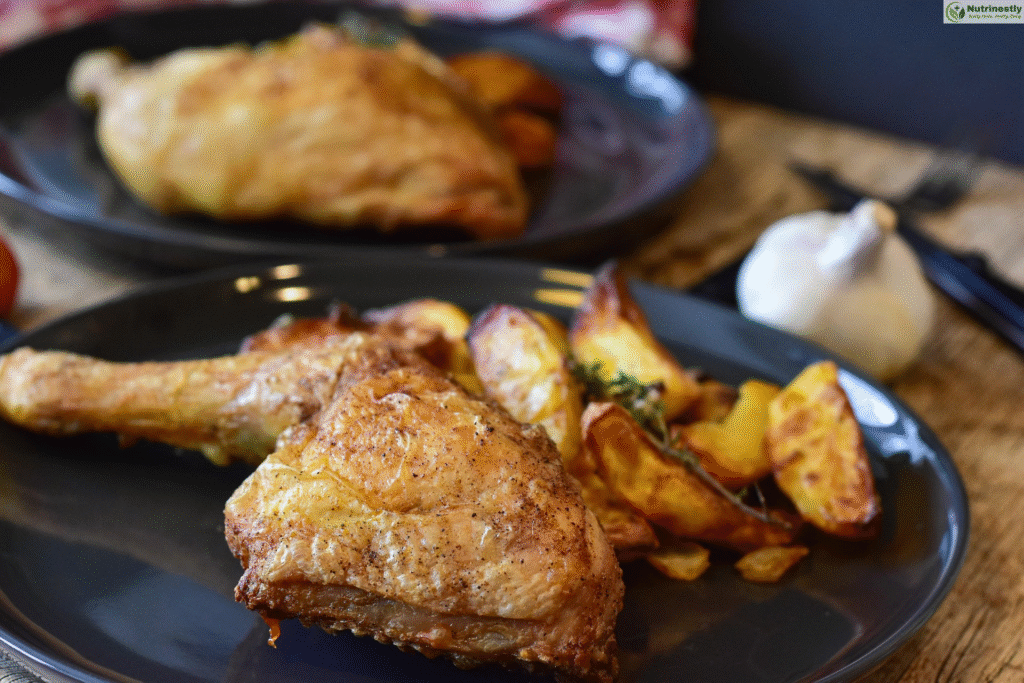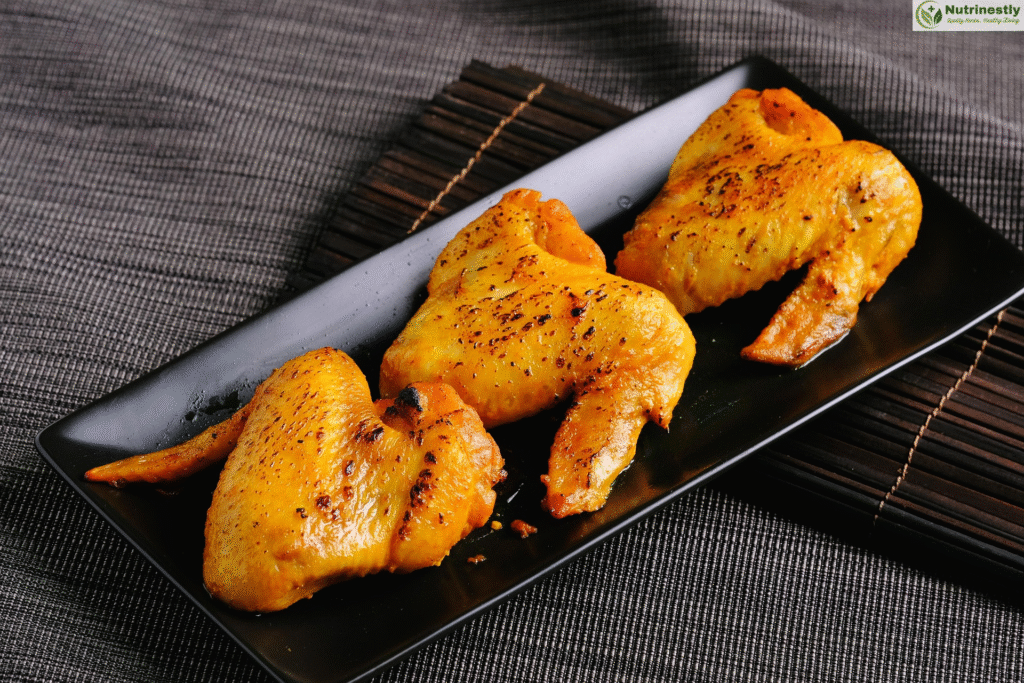
If you’ve been skipping chicken thighs thinking they’re too fatty or unhealthy, it’s time to rethink. The truth is, chicken thighs are not only incredibly delicious and juicy, they’re also packed with essential nutrients that support muscle growth, brain health, and immune function.
In this article, we’ll pull back the skin (sorry, couldn’t resist) and discover the true nutritional content of chicken thighs, how they rank compared to the always-favorite chicken breast, and provide you with some useful tips on cooking them so you can make the most out of this affordable cut. You’ll be smarter when you leave knowing how to best use chicken thighs for your health and taste buds.
2. Nutritional Profile of Chicken Thighs
Skin-On vs. Skinless Chicken Thighs
- Calories (per 100g):
- Skin-on, cooked: ~230–250 kcal
- Skinless, cooked: ~180–200 kcal
- Skin-on, cooked: ~230–250 kcal
- Protein:
- Skin-on: 22g
- Skinless: 24g
- Skin-on: 22g
- Fat:
- Skin-on: 17g (with ~5g saturated fat)
- Skinless: 9g (with ~2.5g saturated fat)
- Skin-on: 17g (with ~5g saturated fat)
- Carbohydrates: 0g (chicken is naturally carb-free)
- Micronutrients:
- High in B vitamins: B6, B12, niacin (B3)
- Rich in zinc, phosphorus, iron, and selenium
- Contains taurine and creatine, compounds linked to muscle health and energy
- High in B vitamins: B6, B12, niacin (B3)
These nutrients are essential for converting food into energy, maintaining nerve function, supporting metabolism, and building red blood cells.
Cooking Affects Nutritional Value

Frying adds calorie and fat value from added oil, particularly if deep-fried or breaded. Although it makes food taste better, it largely increases the saturated fat and overall calorie value, which may not be compatible with some diet objectives.
Baking, grilling, or air-frying are, on the contrary, great ways to maintain the nutritional value of chicken thighs. These approaches preserve vital vitamins and minerals without using excessive fats. Grilling is possible without additives, and air-frying produces a crispy effect with less oil. Herbs, lemon, and olive oil are also great for heart-healthy baking.
For the most health-conscious method, use skinless thighs and cook them through dry heat sources with little oil, which provides a balance of flavor and health.
3. Chicken Thigh vs. Chicken Breast: A Balanced Choice
Though chicken breast contains less fat and more protein per gram, chicken thighs provide a more balanced mix of flavor, moisture, and micronutrients.
| Nutrient | Chicken Thigh (100g, cooked) | Chicken Breast (100g, cooked) |
| Calories | 200–250 | 165 |
| Protein | 22–24g | 30g |
| Fat | 9–17g | 3.5g |
| B12 | Higher | Lower |
| Iron | Higher | Lower |
| Flavor | Rich, juicy | Mild, often dry |
Verdict: Chicken thighs may have more fat, but much of it is unsaturated, and they deliver a richer nutrient profile and taste. For satiety and satisfaction, they’re a clear win.
4. Health Benefits of Chicken Thighs
1. Satiety and Weight Management
They are a balanced food that provides both fat and protein, and both of these regulate hunger by inhibiting digestion. This action can extend the fullness sensation and suppress unnecessary hunger pangs, hence making them a beneficial ingredient in weight loss regimes. In contrast to ultra-low-fat foods that do not take long before hunger pangs start coming back, chicken thighs provide satisfaction with fullness.
2. Muscle Growth and Recovery
Rich in complete protein and amino acids, chicken thighs are a perfect food for repairing and building muscle. They are also rich in creatine and carnosine, substances that increase muscle endurance and recovery, useful for sportsmen and women, particularly during resistance training. The slightly increased fat content promotes hormone production essential for building muscle.
3. Brain and Nervous System Health
Chicken thighs are full of B-complex vitamins such as B6, B12, niacin, and pantothenic acid. These vitamins are involved in brain function, production of neurotransmitters, and preventing dementia. Vitamin B12 also enhances memory, concentration, and mood. The iron and zinc content also helps to improve mental clarity and a healthy nervous system.
4. Immune Support
Zinc and selenium, which are found plentifully in chicken thighs, are two important minerals that constitute a strong immune system. Zinc assists in making white blood cells that battle infection, and selenium is an antioxidant that helps prevent oxidative stress and inflammation. These compounds assist your body in fighting off disease and healing quicker from colds or infections.
5. Iron-Rich for Women and Children
Chicken thighs are rich in heme iron, the most readily absorbed form of iron for the human body. This makes them particularly precious for women of childbearing age, who are more vulnerable to iron deficiency, as well as for children with quickly developing bodies. Proper iron consumption ensures healthy production of blood cells, energy, and general growth and development.
6 Heart Health with the Right Preparation
While others are afraid of chicken thighs’ fat content, much of it is unsaturated—the good-for-your-heart kind. Chicken thighs, when prepared appropriately (grilled or baked, skin removed), can be included in a heart-intelligent diet. They include essential fats that contribute to cholesterol control, and the high selenium content has been associated with lowered cardiovascular disease risk.
7. Hormonal Balance and Skin Health
The occurrence of zinc and B vitamins facilitates the formation of sex hormones such as testosterone and estrogen, which play significant roles in reproductive well-being in women and men. These nutrients also enhance healthy skin by aiding in collagen formation, inhibiting inflammation, and facilitating cell regeneration.
6. Healthy Ways to Cook Chicken Thighs

Best Cooking Methods:
- Grilled (marinated with herbs and spices)
- Baked (with olive oil, lemon, and garlic)
- Air-fried (crispy without excess oil)
- Braised (in tomato-based sauces for flavor depth)
Cooking Tips:
- Use skin-on for grilling, then remove skin before eating to balance taste and calories.
- Marinate with yogurt, citrus, or vinegar-based sauces to tenderize and reduce potential carcinogens from high-heat cooking.
Recipe Ideas:
- Lemon Garlic Baked Chicken Thighs: Serve with quinoa and broccoli.
- Spicy Air-Fried Chicken Thighs: Keto-friendly, high-protein.
- One-Pan Mediterranean Chicken Thighs with Olives, Tomatoes, and Herbs.
7. Who Should Be Eating Chicken Thighs?
- Busy families: Convenient, affordable, and family-friendly.
- Fitness enthusiasts: Excellent post-workout protein with flavor.
- Older adults: Iron, zinc, and B12 boost aging brains and bones.
- Budget-conscious eaters: Less expensive than chicken breast and more satisfying.
8. Conclusion:
Chicken Thighs Have a Place on Your Plate
Chicken thighs aren’t just for decadent dinners or rich stews anymore. They’re a truly healthy choice that fits a healthy lifestyle without sacrificing flavor.
By opting for skinless or removing excess fat, baking rather than frying, and serving with intelligent sides such as vegetables or whole grains, you have all the advantages and zero remorse.
The next time you’re at the market, take a double take at those chicken thighs. You might be surprised to discover that your new go-to protein source was right under your nose all this time.

